
Asplenium is a genus of about 700 species of ferns, often treated as the only genus in the family Aspleniaceae, though other authors consider Hymenasplenium separate, based on molecular phylogenetic analysis of DNA sequences, a different chromosome count, and structural differences in the rhizomes. The type species for the genus is Asplenium marinum.

Asplenium platyneuron, commonly known as ebony spleenwort or brownstem spleenwort, is a fern native to North America east of the Rocky Mountains. It takes its common name from its dark, reddish-brown, glossy stipe and rachis, which support a once-divided, pinnate leaf. The fertile fronds, which die off in the winter, are darker green and stand upright, while the sterile fronds are evergreen and lie flat on the ground. An auricle at the base of each pinna points towards the tip of the frond. The dimorphic fronds and alternate, rather than opposite, pinnae distinguish it from the similar black-stemmed spleenwort.

Ophioglossum vulgatum, commonly known as adder's-tongue, southern adders-tongue or adders-tongue fern, is a species of fern in the family Ophioglossaceae.
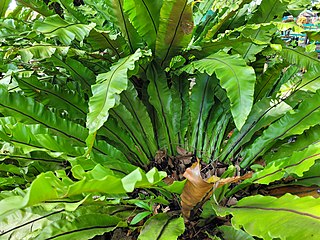
Asplenium nidus is an epiphytic species of fern in the family Aspleniaceae, native to tropical southeastern Asia, eastern Australia, Hawaii, Polynesia, Christmas Island, India, and eastern Africa. It is known by the common names bird's-nest fern or simply nest fern.

Comptonia peregrina is a species of flowering plant in the family Myricaceae. It is the only extant (living) species in the genus Comptonia, although a number of extinct species are placed in the genus. Comptonia peregrina is native to eastern North America, from southern Quebec, east to Nova Scotia, south to the extreme north of Georgia, and west to Minnesota. The common name is sweetfern or sweet-fern, or in Quebec, comptonie voyageuse.
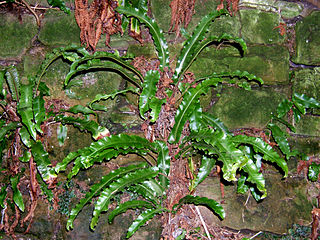
Asplenium scolopendrium, commonly known as the hart's-tongue fern, is an evergreen fern in the genus Asplenium native to the Northern Hemisphere.
Bird's-nest fern is a common name applied to several related species of epiphytic ferns in the genus Asplenium. They grow in a tight, nest-like clump with a lingulate leaf rosette.

Asplenium rhizophyllum, the (American) walking fern, is a frequently-occurring fern native to North America. It is a close relative of Asplenium ruprechtii which is found in East Asia and also goes by the common name of "walking fern".

Asplenium ceterach is a fern species commonly known as rustyback.

Asplenium trichomanes, the maidenhair spleenwort, is a small fern in the spleenwort genus Asplenium. It is a widespread and common species, occurring almost worldwide in a variety of rocky habitats. It is a variable fern with several subspecies.

Asplenium australasicum, the bird's nest fern or crow's nest fern, is an epiphytic Australasian species of fern in the family Aspleniaceae.

Asplenium ruta-muraria is a species of fern commonly known as wall-rue. It is a very small epipetric species, growing exclusively on limestone and other calcareous rocks. Its fronds are bluish-green and are heavily sub-divided, becoming up to 12 cm in length.

Zephyranthes atamasca, commonly known as the atamasco-lily or more generally a rain-lily, is native to the southeastern United States. It grows in swampy forests and coastal prairies, preferring acid boggy soils rich with leaf mold. Following the appearance of broad, grassy leaves in early winter, it blooms in March or April. It has several narrow, linear basal leaves about 0.5 in (13 mm) wide and 10–15 in (25–38 cm) long. Its native range extends from Florida north to Maryland and west to Mississippi. The species is also naturalized in Bermuda and in the Mariana Islands. Both its leaves and bulbs are poisonous.

Asplenium viride is a species of fern known as the green spleenwort because of its green stipes and rachides. This feature easily distinguishes it from the very similar-looking maidenhair spleenwort, Asplenium trichomanes.

Asplenium adiantum-nigrum is a common species of fern known by the common name black spleenwort. It is found mostly in Africa, Europe, and Eurasia, but is also native to a few locales in Mexico and the United States.
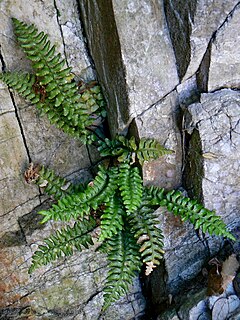
Asplenium marinum is a fern known as the sea spleenwort because of its preference for maritime habitats. Located around the coasts of Europe from Italy in the South to Norway in the North, its most Southern distribution extends to the Northern islands of Tunisia.

Asplenium onopteris, known as the Irish spleenwort or western black spleenwort is a species of fern found mostly throughout the Mediterranean Basin but also around the Eastern Atlantic.
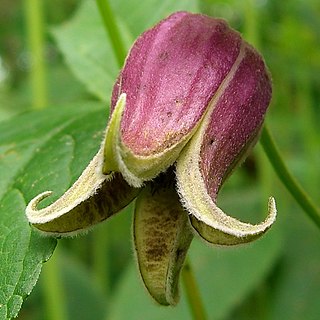
Clematis viorna, commonly known as vasevine or leatherflower, is a flowering vine native to the southeastern United States. It grows in wooded habitats and bears purple flowers in spring and summer.
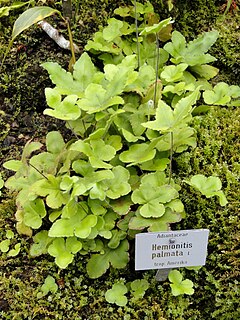
Hemionitis is a genus of ferns in the subfamily Cheilanthoideae of the family Pteridaceae. Its circumscription varies greatly in different systems of fern classification. In the Pteridophyte Phylogeny Group classification of 2016, it was one of more than 20 genera in the subfamily Cheilanthoideae, and was said to have five species. Other sources treat it as the only genus in the subfamily, and so accept about 450 species. With the restricted circumscription, species are native to tropical America.

Asplenium hemionitis is a species of fern native to Macaronesia, Northwest Africa and mainland Portugal. It inhabits humid woods and other shady areas, sometimes in uncovered slopes subject to high ocean humidity.



















